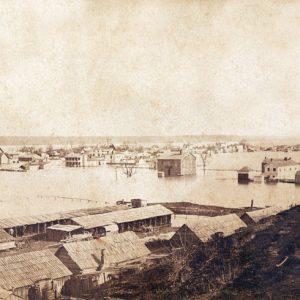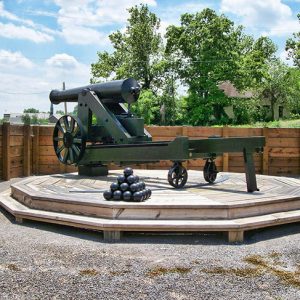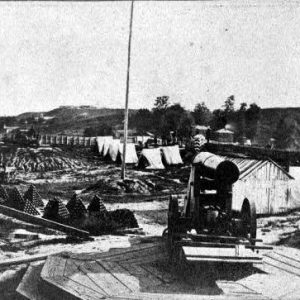calsfoundation@cals.org
Fort Curtis
Fort Curtis was a major Union army fortification located in Helena (Phillips County) during and immediately after the Civil War. It is best known for being part of the Federal defenses at the July 4, 1863, Battle of Helena.
After the Battle of Pea Ridge in March 1862, the Union Army of the Southwest under the command of Major General Samuel Ryan Curtis moved across northern Arkansas and southern Missouri before eventually taking the town of Helena, located on the Mississippi River. Helena would remain under Federal control for the remainder of the war. Located at the end of Crowley’s Ridge, the land around the city was well-suited for a defensive position. Construction on fortifications began almost immediately as the Army of the Southwest was surrounded by potential enemies.
Although the Union army arrived in Helena on July 12, 1862, construction on the fort did not begin until mid-August. Located north of the city where its cannons could reach almost any location, the earthen fortification was named for the commander of the Union forces in the city. Shortly after work began on Fort Curtis, the Union commanders in Helena realized that additional fortifications were needed to defend the city. Four batteries, named A, B, C, and D, were constructed on the outskirts of the city. Fort Curtis was located between—and slightly to the east of—Batteries B and C. Additional fortifications were located between the batteries. Federal troops as well as freed slaves worked to construct the fortifications. Fort Curtis was dedicated on October 30, 1862.
For the next year, Fort Curtis served as an important command post in eastern Arkansas. In the summer of 1863, Confederate forces under the command of Lieutenant General Theophilus Holmes gathered for an attack on the city in an effort to provide some relief for their comrades under siege at Vicksburg, Mississippi, and to push the largest contingent of Federals out of Arkansas. Advancing to within a few miles of the city on July 3, the Confederate forces prepared to attack early the next morning. Inadequate reconnaissance of the Helena fortifications led the commanders to create a plan that relied heavily on simultaneous frontal assaults across the city. Aware of a possible attack, the commander of the Federal forces in the city, Major General Benjamin Prentiss, ordered his men to awaken at 2:00 a.m. on the morning of July 4. At 3:30 a.m., a single cannon in Fort Curtis fired to warn the Union troops of the impending attack. The fort was defended by six thirty-two-pound siege guns. As the battle opened, Fort Curtis was not directly attacked by the Confederates, who directed their attention to the batteries. Artillery pieces inside the fort shelled the approaching Confederates with ease. The attackers were able to capture Battery C, and Holmes ordered these troops to continue their assault with a charge against Fort Curtis across 700 yards of open ground. The attack failed before it reached the fort. By 10:30, Confederate forces began to retreat, bringing the battle to a close.
Helena was not seriously threatened by Confederate forces again for the remainder of the war and also served as the base for the successful campaign to capture Little Rock (Pulaski County) in September 1863. Fort Curtis continued to serve the Federal army, and several units were stationed there until 1866. After the war, Fort Curtis was abandoned, and the city of eventually Helena grew around it.
An endeavor was launched in 2005 to increase economic development in Phillips County, and an effort to rebuild Fort Curtis was part of that plan. The reconstructed fort was dedicated in Helena-West Helena on May 11, 2012, and is open to the public.
For additional information:
Bearss, Edwin. “The Battle of Helena, July 4, 1863.” Arkansas Historical Quarterly 20 (Autumn 1961): 256–297.
Christ, Mark K. Civil War Arkansas, 1863: The Battle for a State. Norman: University of Oklahoma Press, 2010.
Civil War Helena. http://civilwarhelena.com/ (accessed October 13, 2021).
Fort Curtis. https://www.arkansas.com/helena-west-helena/attractions-culture/fort-curtis (accessed October 13, 2021).
David Sesser
Henderson State University
 Military
Military Fort Curtis
Fort Curtis  Fort Curtis
Fort Curtis  Fort Curtis Cannon
Fort Curtis Cannon  Fort Curtis
Fort Curtis 




Comments
No comments on this entry yet.